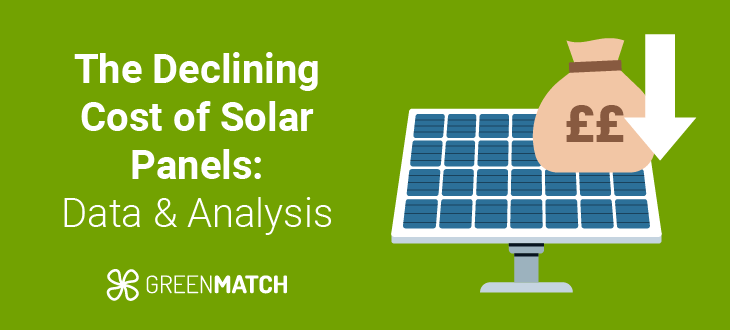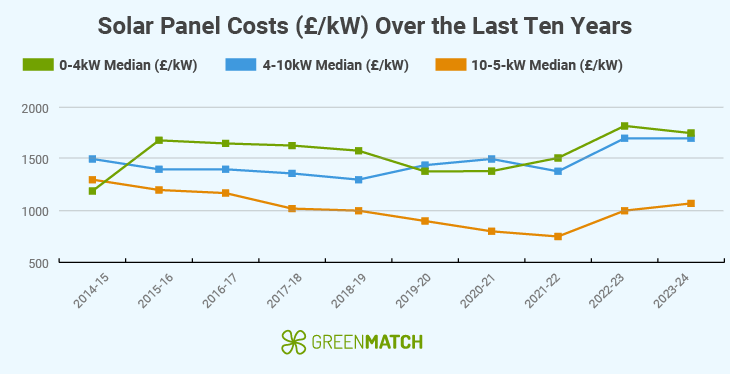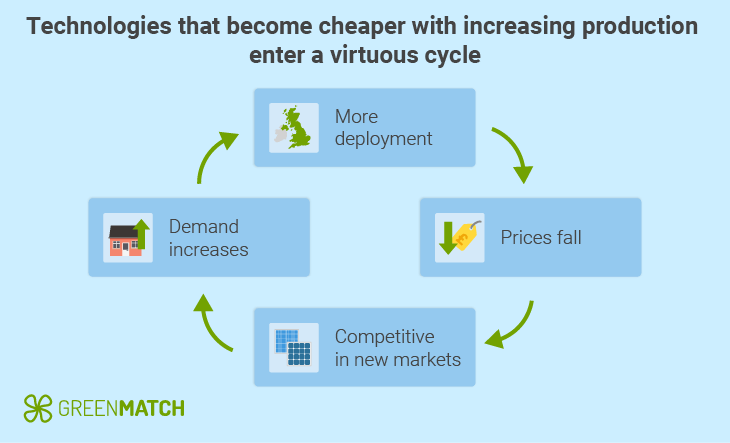- GreenMatch
- Blog
- The Declining Cost of Solar Panels
The Declining Cost of Solar Panels: Data & Analysis


- Over the past decade, the cost of solar panels has decreased globally by 90%, now being under $0.20 (£0.15) per watt.
- Conversion efficiency improved from 1–2% to 22% within the past century, reducing manufacturing and installation costs.
- Incentives like the Feed-in Tariff and Smart Export Guarantee have driven adoption and cost reduction.
- Prices are expected to drop to $0.097 (£0.075) per watt by 2030, further accelerating adoption.
Solar panels, once an expensive product, are now the cheapest they have ever been, with prices declining every year worldwide. This dramatic decline is a huge win for sustainability. As solar panel costs become more accessible, homeowners and businesses are now able to implement greener energy solutions. This shift helps reduce carbon emissions and promotes a more sustainable future.
In the last decade, solar panel costs have fallen by 90% worldwide, according to Our World Data.

To accelerate sustainable practices and encourage more people and governments to adopt solar energy, it is important to forecast the future costs of solar panels. Forecasting future costs relies on looking at its decline and the factors that contribute to it. In this article, we delve into the breakdown of the cost evolution of solar panels, the reasons for their decline, and the future outlook of solar panel prices.
Cost evolution of solar panels over the last decade in the UK

Over the last ten years, the cost of solar panels in the UK has seen a repetitive pattern of rises and falls rather than a steady decline. While overall, solar panel costs have decreased substantially, short-term trends show that the evolution of the cost of solar panels has been impacted by policies, global demand, and supply disruptions.
Data collected by GOV.UK shows that the cost of solar panels in March 2024 either decreased, increased or remained stable depending on the wattage from the previous year.
- 0-4kW solar panel cost decreased by 4.7%
- 4-10kW solar panel cost remained stable.
- 10-50kW solar panel cost increased by 5.8%.
The above shows that within a single year, supply and demand influence solar panel prices. To better understand these cost trends, we have compiled a table showing the annual cost per kilowatt (kW) from 2014 to 2024, which has been adjusted according to inflation.
Adjustment of inflation is important as the value of money can change over time. Without adjusting for inflation, costs may seem to rise or fall more than they have. Below, we can see the true cost trend of solar panel prices over the last ten years:
| Financial year | 0-4kW median (£/kW) | 4-10kW median (£/kW) | 10-50kW median (£/kW) |
|---|---|---|---|
| 2014-2015 | £1,190 | £1,505 | £1,302 |
| 2015-2016 | £1,662 | £1,397 | £1,210 |
| 2016-2017 | £1,642 | £1,391 | £1,133 |
| 2017-2018 | £1,629 | £1,335 | £1,030 |
| 2018-2019 | £1,576 | £1,295 | £1,013 |
| 2019-2020 | £1,369 | £1,455 | £0,946 |
| 2020-2021 | £1,375 | £1,476 | £917 |
| 2021-2022 | £1,532 | £1,355 | £898 |
| 2022-2023 | £1,829 | £1,691 | £1,001 |
| 2023-2024 | £1,742 | £1,694 | £1,059 |
Key points from the table
Several key factors have impacted the cost of solar panels in the UK over the past ten years:
- Government incentives: As of 2019, the Feed in Tariff (which paid homeowners and businesses for generating renewable energy) ended. This resulted in a decrease in installation and, therefore, a decrease in overall cost.
- Supply chain disruption: In 2020, COVID-19 slowed down manufacturing and transportation, resulting in fewer installations and reduced costs.
These moments throughout the past decade show how policies and supply can impact the cost of solar panels.
Key statistics
- In 1956, 1 watt of solar photovoltaic cost $1865 (£1437.94), which, if adjusted to inflation prices, means that today it would cost $596,800 (£459,956).
- In 1958, the US Navy funded Vanguard 1, the first solar-powered spacecraft; this is an early example of government funding that helped drive technological advancements and reduce costs.
- The cost of solar panels has fallen by 99% since the 1970s, from about $100 per watt (£77.09) to just under $0.20 per watt (£0.15) today.
- Government incentives and policies have contributed to 60% of the overall decline in solar panel costs worldwide, with half of that coming from government-backed funding.
- In the last ten years, solar panel costs have decreased by 90%.
- Solar energy is now cheaper than fossil fuels globally, with solar energy plants costing £18.49 per megawatt-hour, compared to £27.74 per megawatt-hour for coal plants.
- In the UK, the Feed-in Tariff (FiT) (2010–2019) supported solar adoption and helped drive down costs through increased installation volumes.
- The Smart Export Guarantee (SEG) has increased solar energy in the UK by allowing solar panel owners to sell off their excess energy back to the grid, encouraging further adoption, which contributes to the decline in costs.
- China owns about 80% of solar panel manufacturing, which has contributed to the reduction of solar panel costs globally.
- Solar panel prices have fallen by approximately 20% every time global capacity has doubled, following a trend known as Wright's Law.
- Solar panels can convert 22% of sunlight into electricity, whereas the first solar panels could only convert 1-2% into electricity. This has helped drive down costs as the panels are more efficient.
- As of January 2024, the UK’s total solar capacity reached 15.7 gigawatts, marking a 6.6% increase in the previous year.
- As of 2024, 82% of people in the UK support renewable energy.
- The virtuous cycle refers to increased solar panel production driving down costs, which accelerates adoption and further reduces prices.
Why have solar panels come down in price?
Solar energy has become one of the cheapest energy sources throughout the world. Globally, the cost of solar panels has decreased by 90% in the last decade. This decline has been driven by a number of factors, including technological advancements, increased production efficiency, better government incentives and policies, competition between manufacturers and cheaper material costs.
Understanding the factors behind why solar panel costs have been reduced can help explain how solar power has become one of the most cost-effective renewable energy sources available today.
Technological advancements

Technological advancements in solar panels have been one of the driving forces behind the deduction of costs. One of the main technological advancements is the conversion efficiency of solar panels.
Conversion efficiency of solar panels refers to the amount of sunlight that can be absorbed by the panels and converted into usable electricity.
The first solar cell created by Charles Fritts in 1883 could only convert about 1 to 2% of solar energy into electricity, but in today's world, solar energy can convert around 22%, according to the University of Oxford.
With an increase in conversion efficiency, solar energy requires fewer panels to produce the same amount of energy. This means manufacturing, installation, transport, and maintenance costs decrease. A 2017 study found that an increase in module efficiency was the leading cause of cost reduction between 1980 and 2012, which contributed to about 25% of the decline in the cost of solar panels.
Continuous research into solar technology is expected to increase efficiency and lower costs. A major focus is on perovskites, a family of crystalline compounds that researchers believe could make solar panels cheaper, more flexible, and easier to manufacture.
Experiments have shown this compound to have a conversion efficiency rate of 33.9%, which is much higher than current levels. Although more research is needed, this research shows that technological advancements will continue to improve solar energy while lowering costs.
Government incentives and policies
The increase in government incentives and policies has accounted for about 60% of the overall cost decline in solar panels, according to MIT. These policies and incentives are encouraged by the declining availability and cost of fossil fuels and a push for a greener future.
Many countries, including the UK, are attempting to reach net-zero emissions by 2050. This has incentivised governments to focus on renewable energy, as burning fossil fuels accounts for 87% of the world's CO2 emissions, according to Our World Data.
Additionally, the cost of energy, especially in the UK, has risen in recent years; this has pushed for more sustainable energy incentives to help homeowners and businesses afford electricity while also pushing down the nation's carbon footprint.
To encourage solar panel usage, the UK government has implemented the Smart Export Guarantee (SEG), which allows solar panel owners to sell excess energy back to the grid. According to our estimates, people can earn between £80 to £170 per year. These policies stimulate market growth, increase production, and help lower costs.
On top of government incentives, global government policies have impacted the sale of solar energy. Here are a few of the top government policies:
| Region | Policy | Date introduced | Goals |
|---|---|---|---|
| China | 14th Five Year Plan for Renewable Energy | June 2022 | 33% of electricity from renewables by 2025 |
| United States | Inflation Reduction Act | August 2022 | Expands support for renewable energy over 10 years through tax credits and other measures |
| European Union | REPowerEU Plan and Green Deal Industrial Plan | May 2022, February 2023 | 45% renewable energy by 2030 |
| India | COP26 Pledge | November 2021 | 500 GW of non-fossil capacity and 50% renewable electricity by 2030; net zero by 2070 |
Government policies like those above have reduced solar panel costs by increasing market demand and encouraging large-scale production. As a result, more governments are investing in research and development of solar energy. Of the total 60% reduction, government funding accounts for half.
Production scales
The decline in solar panel costs has also been influenced by the increase in production scale. As demand for solar energy rises, more solar panels are produced, leading to lower costs through economies of scale. This creates a virtuous cycle where increased production lowers costs, which in turn drives higher demand and further production growth. Here are the main reasons why production scales reduce solar panel costs:
- Bulk purchasing: Manufacturers purchasing supplies and materials in larger quantities can secure better deals, reducing the cost per unit.
- Streamlined production process: Increased production helps producers optimise the production process, reducing time and cost.
This virtuous cycle of rising demand, increased production, and lower costs has been a key driver in making solar energy more affordable and accessible worldwide.
Competition and market maturity
The growing demand for solar panels has increased competition between different manufacturers and producers. More manufacturers have entered the market, which has driven innovation and efficiency.
Additionally, to make themselves more desirable to consumers and drive up sales, many manufacturers are attempting to reduce the overall cost of solar panels. China has invested up to $50 billion in solar PV since 2011, according to the IEA. This has led China to dominate 80% of solar manufacturing, which has decreased the overall cost of production worldwide.
Additionally, market maturity has improved solar panel production which has helped the decline in costs. With better supply chains available, a more improved production process and an experienced workforce, the process of creating solar panels is more efficient, resulting in lower prices.
This combination of intense competition and market maturity has created a self-reinforcing cycle where lower costs drive greater adoption, which in turn attracts more investment and encourages further price reductions.
Solar panel installation cost breakdown
Solar panel costs in the UK do not only comprise of just the actual solar panel. There are several other elements in the installation of solar panels which contribute to the overall price.
On average, a 1kW solar panel system ranges from £1,500 to £3,000, depending on the manufacturer. Understanding this breakdown helps to clarify where costs can be reduced and helps you budget effectively for new solar panels.
| Component | Average cost | Percentage of total cost |
|---|---|---|
| Solar panels system and installation | £2,500 – £10,500 | 33.6% |
| Mounting Systems and racking | £600 – £2,500 | 8.0% |
| Inverters | £500 – £1,500 | 5.2% |
| Electrical work | £600 – £3,000 | 9.3% |
| Solar battery (optional) | £2,500 – £10,000 | 38.8% |
| Monitoring systems (optional) | £500 – £1,500 | 5.2% |
To calculate the cost of solar panels, multiply the system size (kW) by the cost per kW, then add installation, inverter, and battery costs. Subtract any government incentives or earnings from programs like the Smart Export Guarantee (SEG) to get the net cost.
The shift towards solar energy has been driven partly by the rising costs of fossil fuels. Today, fossil fuels still account for up to 79% of the world’s energy production. However, coal and gas have become increasingly expensive. According to The Guardian, coal plants have an average cost of $36 (£27.74) per megawatt-hour (MWh), while solar energy plants cost about $24 (£18.49) per MWh.
As production scales have increased and competition has intensified, the solar panel cost has declined rapidly. However, technological advances still need to be made in order to streamline the system design and installation process and further reduce solar energy costs.
Solar panel price forecast
Over the past several decades, solar panel costs have dramatically declined, making it more accessible and affordable to everyday people. While solar panels are still relatively expensive, costing between £2,500 to £10,500, government incentives and solar panel grants have made solar energy even more accessible.
Solar panels are expected to drop even further in the future if trends continue. According to PV magazine, experts believe that by 2030, solar panel prices will drop to an astonishing $0.097 (£0.075) per watt. This decline is expected to fuel the virtuous cycle, meaning lower costs will drive technological advancements, improve the production process and increase economies of scale, resulting in even lower prices.
The transition to solar panels and clean energy is essential for a greener and more sustainable future.
According to Reuters, clean energy costs are expected to fall by 22-49% by 2030. As solar panel prices decrease, more people are likely to adopt solar energy. This will reduce our reliance on fossil fuels and contribute to a sustainable future.
FAQ
Solar panel costs have decreased by about 90% in the last ten years and 99% in the last four decades.
Technological advancements, increased competition between manufacturers, government incentives, increased production efficiency, and economies of scale have driven the decline in solar panel costs.
To calculate the cost of installing solar panels, you will need to multiply the total wattage of the system by the cost per watt, then add installation fees and any additional equipment costs.
If trends continue, solar panel costs will continue to fall; it is predicted that by 2030, solar panels could cost around £0.075 per watt.
Solar energy is now cheaper than fossil fuels, with solar plants costing around £18.49 per megawatt-hour compared to £27.74 for coal plants.

Caoimhe is an experienced content writer and researcher who is passionate about providing accessible information to every reader. With a background in English literature and Sociology, she combines the two disciplines to create cohesive, well-thought-out, and well-informed pieces.
We strive to connect our customers with the right product and supplier. Would you like to be part of GreenMatch?

Stay up to date with energy saving tips and grant alerts
Receive offers, marketing and promotions via email from Leads.io about GreenMatch and our brands/partners to help you save.
Thank you for subscribing to our newsletter!
Your email has been successfully added to our list. We look forward to sharing our latest updates with you soon!
